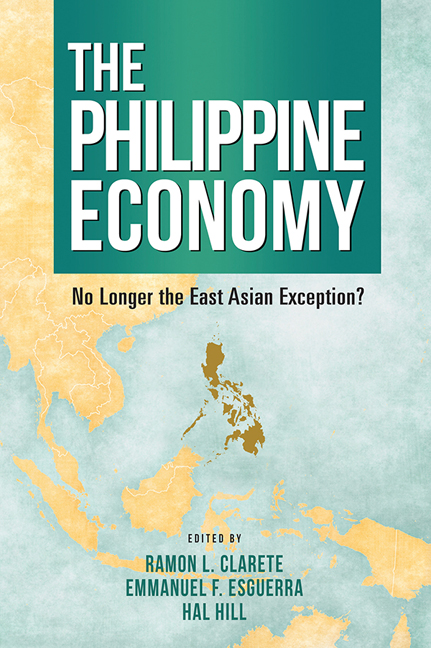Book contents
- Frontmatter
- Contents
- List of Figures
- List of Tables
- Foreword by Arsenio M. Balisacan
- Preface
- About the Contributors
- 1 The Philippine Economy: An Overview
- 2 Economic Growth and Poverty Reduction
- 3 Infrastructure and Urbanization
- 4 Education and Training
- 5 Universal Health Coverage, Health Security and Resilient Health Systems
- 6 Environmental Resources, Shocks and National Well-Being
- 7 Energy: Power Security and Competitiveness
- 8 Development Finance
- 9 Governance and Institutions
- Index
1 - The Philippine Economy: An Overview
Published online by Cambridge University Press: 12 February 2019
- Frontmatter
- Contents
- List of Figures
- List of Tables
- Foreword by Arsenio M. Balisacan
- Preface
- About the Contributors
- 1 The Philippine Economy: An Overview
- 2 Economic Growth and Poverty Reduction
- 3 Infrastructure and Urbanization
- 4 Education and Training
- 5 Universal Health Coverage, Health Security and Resilient Health Systems
- 6 Environmental Resources, Shocks and National Well-Being
- 7 Energy: Power Security and Competitiveness
- 8 Development Finance
- 9 Governance and Institutions
- Index
Summary
Introduction
The Philippines has long been viewed as the “East Asian exception”. Although suffering massive wartime destruction, in the 1950s and 1960s its economic prospects were considered to be favourable. While very poor, its per capita income was somewhat higher than most of its neighbours. In the post-colonial era it neither closed off from the global economy — as China, Indonesia and Myanmar did — nor was it overwhelmed by the conflict that engulfed Indochina. Its civil society and polity appeared to be among the most robust in developing East Asia. And it retained close commercial and political ties with the undisputed global super power of that era, the United States. As a vote of confidence, Manila was selected to be the headquarters of the Asia Pacific's premier development finance institution, the Asian Development Bank, in 1966.
However, these early high expectations were not realized. From the late 1960s the Philippines increasingly parted company with its neighbours, as first the four Asian NIEs, then the ASEAN four (i.e., Indonesia, Malaysia, Thailand, together with Singapore) and, most important of all, China began to register exceptionally high rates of economic growth. By contrast, Philippine economic growth began to falter, especially from the late 1970s, and particularly during the country's deep economic and political crisis in the mid-1980s. The collapse of the two-decade Marcos rule in early 1986 was accompanied by the sharpest economic contraction in the country's economic history as an independent nation state. The economy was in free fall, with GDP declining by about 15 per cent in the years 1984'86 and poverty incidence rising sharply. Thereafter, a fragile political system was gradually constructed, punctuated by periodic political instability and extended debt negotiations. This was the country's lost decade, as most of East Asia boomed, fuelled by a newly dynamic China and the relocation of labour-intensive manufacturing from Northeast to Southeast Asia. At the turn of the century, Philippine per capita income (PCI) had not progressed beyond that achieved in 1980.
Comparative surveys of Asian economic development have highlighted, and puzzled over, the country's divergent economic path. A leading contributor to the literature on growth empirics speculated that the country was “a democratic dud” (Pritchett 2003).
- Type
- Chapter
- Information
- The Philippine EconomyNo Longer The East Asian Exception?, pp. 1 - 52Publisher: ISEAS–Yusof Ishak InstitutePrint publication year: 2018

